Technologies Associated with Industry 4.0 in Green Supply Chains: A Systematic Literature Review
Abstract
1. Introduction
- RQ1: How does the literature describe the contribution of individual or combined Industry 4.0-related technologies to the implementation of a GSC?
- RQ2: In which aspects of the GSC is the implementation of Industry 4.0-associated technologies being studied? What are the benefits of this implementation?
- RQ3: What challenges of implementing technologies related to Industry 4.0 in a GSC have been identified from the literature?
2. Literature Review
2.1. Green Supply Chain
- Green warehousing: implementing environmentally friendly practices in warehousing can save cost and energy [32].
- Green design: Product design that considers the environmental issues. This design reduces material and energy consumption. The environmental impacts of products during their life cycle are reduced too. Moreover, these products are designed to enable easy disassembly and, therefore, easy remanufacturing and recycling [30,33].
- Green manufacturing: manufacturing and production processes are re-engineered to reduce their environmental impacts, e.g., minimum waste generation, energy saving, or cleaner production [30].
- Carbon management: Carbon emissions are considered an important element in GSC because 80% of carbon emissions are produced by supply chains. Carbon footprint monitoring helps to identify how to reduce carbon footprint. This reduction means reducing manufacturing costs and energy consumption [34].
2.2. Industry 4.0 and Enabling Technologies
2.3. GSC and Technologies That Enable Industry 4.0
2.4. Gaps Identified in Literature Review
3. Methodology
3.1. RQ Definition
3.2. Database Selection
3.3. Material Collection
3.4. Material Refinement
3.5. Data Extraction and Analysis
- Reverse logistic;
- Green warehousing;
- Green design;
- Green manufacturing;
- Carbon emissions management.
4. Literature Review Analysis
4.1. Descriptive Analysis
4.2. Content Analysis
4.2.1. RQ1: How Does the Literature Describe the Contribution of Individual or Combined Industry 4.0-Related Technologies to the Implementation of a GSC?
4.2.2. RQ2: In Which Aspects of the GSC Is the Implementation of Industry 4.0 Technologies Being Studied in? What Are the Benefits of This Implementation?
4.2.3. RQ3: What Challenges of Implementing Industry 4.0 Technologies in a GSC Have Been Identified from the Literature?
5. Discussion
- More successful case studies on the implementation of technologies are needed. This research shows that many authors support the theory that 4.0 technologies can benefit GSCs, but more case studies and applications in real environments are needed to reinforce the idea proposed in theory.
- Our study does not approach the social dimension of supply chains since it studies GSCs and not sustainable supply chains. Further research could analyze the implementation of Industry 4.0-associated technologies in sustainable supply chains to address and integrate the social dimension.
- Considering the importance of implementing technologies associated with Industry 4.0 for greening the supply chain and how they are being extrapolated to other areas, such as everyday life, it would be interesting to study the transfer of this concept to other sectors such as healthcare or agri-food.
- This study has identified a lack of standardization in technology implementation and performance measurements. Further studies could focus on developing standards and protocols for introducing and measuring green issues, as well as for implementing new technologies. In addition, future research could be dedicated to studying and developing indicators that measure the economic or environmental benefits of implementing 4.0 technologies.
- It is necessary to extend the study of challenges found in the implementation of 4.0 technologies. This study analyzes the challenges of implementing Industry 4.0-related technologies in a GSC to establish a roadmap for facing these challenges.
6. Conclusions and Future Research Agenda
Supplementary Materials
Author Contributions
Funding
Conflicts of Interest
References
- Nascimento, D.L.M.; Alencastro, V.; Quelhas, O.L.G.; Caiado, R.G.G.; Garza-Reyes, J.A.; Rocha-Lona, L.; Tortorella, G. Exploring Industry 4.0 technologies to enable circular economy practices in a manufacturing context: A business model proposa. J. Manuf. Technol. Manag. 2019, 30, 607–627. [Google Scholar] [CrossRef]
- Micheli, G.J.; Cagno, E.; Mustillo, G.; Trianni, A. Green supply chain management drivers, practices and performance: A comprehensive study on the moderators. J. Clean. Prod. 2020, 259, 121024. [Google Scholar] [CrossRef]
- Ying, J.; Li-Jun, Z. Study on Green Supply Chain Management Based on Circular Economy. Phys. Procedia 2012, 25, 1682–1688. [Google Scholar] [CrossRef]
- Kazancoglu, Y.; Kazancoglu, I.; Sagnak, M. A new holistic conceptual framework for green supply chain management performance assessment based on circular economy. J. Clean. Prod. 2018, 195, 1282–1299. [Google Scholar] [CrossRef]
- Xu, L.D.; Xu, E.L.; Li, L. Industry 4.0: State of the art and future trends. Int. J. Prod. Res. 2018, 56, 2941–2962. [Google Scholar] [CrossRef]
- Luthra, S.; Mangla, S.K. Evaluating challenges to Industry 4.0 initiatives for supply chain sustainability in emerging economies. Process Saf. Environ. Prot. 2018, 117, 168–179. [Google Scholar] [CrossRef]
- Zhao, J.; Ji, M.; Feng, B. Smarter supply chain: A literature review and practices. J. Data, Inf. Manag. 2020, 2, 95–110. [Google Scholar] [CrossRef]
- Zhang, G.; Chen, C.-H.; Zheng, P.; Zhong, R.Y. An integrated framework for active discovery and optimal allocation of smart manufacturing services. J. Clean. Prod. 2020, 273, 123144. [Google Scholar] [CrossRef]
- Dev, N.K.; Shankar, R.; Qaiser, F.H. Industry 4.0 and circular economy: Operational excellence for sustainable reverse supply chain performance. Resour. Conserv. Recycl. 2020, 153, 104583. [Google Scholar] [CrossRef]
- Anser, M.K.; Khan, M.A.; Awan, U.; Batool, R.; Zaman, K.; Imran, M.; Sasmoko; Indrianti, Y.; Khan, A.; Abu Bakar, Z. The Role of Technological Innovation in a Dynamic Model of the Environmental Supply Chain Curve: Evidence from a Panel of 102 Countries. Processes 2020, 8, 1033. [Google Scholar] [CrossRef]
- Ćwiklicki, M.; Wojnarowska, M. Circular Economy and Industry 4.0: One-Way or Two-way Relationships. Eng. Econ. 2020, 31, 387–397. [Google Scholar] [CrossRef]
- Machado, C.G.; Winroth, M.P.; Ribeiro Da Silva, E.H.D. Sustainable manufacturing in Industry 4.0: An emerging research agenda. Int. J. Prod. Res. 2020, 58, 1462–1484. [Google Scholar] [CrossRef]
- Fritzsche, K.; Niehoff, S.; Beier, G. Industry 4.0 and Climate Change—Exploring the Science-Policy Gap. Sustainability 2018, 10, 4511. [Google Scholar] [CrossRef]
- Borregan-Alvarado, J.; Alvarez-Meaza, I.; Cilleruelo-Carrasco, E.; Garechana-Anacabe, G. A Bibliometric Analysis in Industry 4.0 and Advanced Manufacturing: What about the Sustainable Supply Chain. Sustainability 2020, 12, 7840. [Google Scholar] [CrossRef]
- Furstenau, L.B.; Sott, M.K.; Kipper, L.M.; Machado, E.L.; Lopez-Robles, J.R.; Dohan, M.S.; Cobo, M.J.; Zahid, A.; Abbasi, Q.H.; Imran, M.A. Link Between Sustainability and Industry 4.0: Trends, Challenges and New Perspectives. IEEE Access 2020, 8, 140079–140096. [Google Scholar] [CrossRef]
- Gajdzik, B.; Grabowska, S.; Saniuk, S.; Wieczorek, T. Sustainable Development and Industry 4.0: A Bibliometric Analysis Identifying Key Scientific Problems of the Sustainable Industry 4.0. Energies 2020, 13, 4254. [Google Scholar] [CrossRef]
- Birkel, H.; Müller, J.M. Potentials of industry 4.0 for supply chain management within the triple bottom line of sustainability—A systematic literature review. J. Clean. Prod. 2021, 289, 125612. [Google Scholar] [CrossRef]
- Jabbour, C.J.C.; Fiorini, P.D.C.; Ndubisi, N.O.; Queiroz, M.M.; Piato, L. Digitally-enabled sustainable supply chains in the 21st century: A review and a research agenda. Sci. Total. Environ. 2020, 725, 138177. [Google Scholar] [CrossRef]
- Lim, K.Y.H.; Zheng, P.; Chen, C.-H. A state-of-the-art survey of Digital Twin: Techniques, engineering product lifecycle management and business innovation perspectives. J. Intell. Manuf. 2020, 31, 1313–1337. [Google Scholar] [CrossRef]
- Srivastava, S.K. Green supply-chain management: A state-of-the-art literature review. Int. J. Manag. Rev. 2007, 9, 53–80. [Google Scholar] [CrossRef]
- Ahi, P.; Searcy, C. A comparative literature analysis of definitions for green and sustainable supply chain management. J. Clean. Prod. 2013, 52, 329–341. [Google Scholar] [CrossRef]
- Namagembe, S.; Ryan, S.; Sridharan, R. Green supply chain practice adoption and firm performance: Manufacturing SMEs in Uganda. Manag. Environ. Qual. Int. J. 2019, 30, 5–35. [Google Scholar] [CrossRef]
- Panpatil, S.S.; Kant, R. Green supply chain management implementation: Modeling the green supply chain practices (GSCPs). J. Adv. Manag. Res. 2022, 19, 389–413. [Google Scholar] [CrossRef]
- Kuei, C.-H.; Madu, C.N.; Chow, W.S.; Chen, Y. Determinants and associated performance improvement of green supply chain management in China. J. Clean. Prod. 2015, 95, 163–173. [Google Scholar] [CrossRef]
- Perotti, S.; Zorzini, M.; Cagno, E.; Micheli, G.J. Green supply chain practices and company performance: The case of 3PLs in Italy. Int. J. Phys. Distrib. Logist. Manag. 2012, 42, 640–672. [Google Scholar] [CrossRef]
- Laosirihongthong, T.; Adebanjo, D.; Tan, K.C. Green supply chain management practices and performance. Ind. Manag. Data Syst. 2013, 113, 1088–1109. [Google Scholar] [CrossRef]
- Zhu, Q.; Sarkis, J.; Lai, K.-H. Confirmation of a measurement model for green supply chain management practices implementation. Int. J. Prod. Econ. 2008, 111, 261–273. [Google Scholar] [CrossRef]
- Islam, S.; Karia, N.; Fauzi, F.B.A.; Soliman, M. A review on green supply chain aspects and practices. Manag. Mark. 2017, 12, 12–36. [Google Scholar] [CrossRef]
- Govindan, K.; Soleimani, H.; Kannan, D. Reverse logistics and closed-loop supply chain: A comprehensive review to explore the future. Eur. J. Oper. Res. 2015, 240, 603–626. [Google Scholar] [CrossRef]
- Tseng, M.-L.; Chiu, A.S.F. Evaluating Firm’s Green Supply Chain Management in Linguistic Preferences. J. Clean. Prod. 2013, 40, 22–31. Available online: https://www.academia.edu/5949048/Evaluating_firms_green_supply_chain_management_in_linguistic_preferences (accessed on 18 February 2022).
- Büyüközkan, G.; Çifçi, G. A novel hybrid MCDM approach based on fuzzy DEMATEL, fuzzy ANP and fuzzy TOPSIS to evaluate green suppliers. Expert Syst. Appl. 2012, 39, 3000–3011. [Google Scholar] [CrossRef]
- Rostamzadeh, R.; Govindan, K.; Esmaeili, A.; Sabaghi, M. Application of fuzzy VIKOR for evaluation of green supply chain management practices. Ecol. Indic. 2015, 49, 188–203. [Google Scholar] [CrossRef]
- Lin, C.; Kuei, C.; Chai, K. Identifying critical enablers and pathways to high performance supply chain quality management. Int. J. Oper. Prod. Manag. 2013, 33, 347–370. [Google Scholar] [CrossRef]
- Lee, K.-H. Integrating carbon footprint into supply chain management: The case of Hyundai Motor Company (HMC) in the automobile industry. J. Clean. Prod. 2011, 19, 1216–1223. [Google Scholar] [CrossRef]
- Sigov, A.; Ratkin, L.; Ivanov, L.A.; Da Xu, L. Emerging Enabling Technologies for Industry 4.0 and Beyond. Inf. Syst. Front. 2022, 1, 1–11. [Google Scholar] [CrossRef]
- Da Xu, L. Industry 4.0-Frontiers of fourth industrial revolution. Syst. Res. Behav. Sci. 2020, 37, 531–534. [Google Scholar] [CrossRef]
- Ghobakhloo, M. The future of manufacturing industry: A strategic roadmap toward Industry 4.0. J. Manuf. Technol. Manag. 2018, 29, 910–936. [Google Scholar] [CrossRef]
- Gilchrist, A. Industry 4.0: The Industrial Internet of Things; Springer: Berlin/Heidelberg, Germany, 2016. [Google Scholar]
- Deepa, B.; Srigayathri, S.; Visalakshi, S. A Review on Cloud Computing. Int. J. Trend Res. Dev. 2018, 38, 280–284. Available online: https://www.researchgate.net/publication/327366291_A_Review_on_Cloud_Computing (accessed on 18 February 2022).
- Divya, K.; Jeyalatha, S. Key technologies in cloud computing. In Proceedings of the 2012 International Conference on Cloud Computing Technologies, Applications and Management (ICCCTAM), Dubai, United Arab Emirates, 8–10 December 2012; pp. 196–199. [Google Scholar] [CrossRef]
- Frank, A.G.; Dalenogare, L.S.; Ayala, N.F. Industry 4.0 technologies: Implementation patterns in manufacturing companies. Int. J. Prod. Econ. 2019, 210, 15–26. [Google Scholar] [CrossRef]
- Holmström, J.; Holweg, M.; Lawson, B.; Pil, F.K.; Wagner, S.M. The digitalization of operations and supply chain management: Theoretical and methodological implications. J. Oper. Manag. 2019, 65, 728–734. [Google Scholar] [CrossRef]
- Tung, K. AI, the internet of legal things, and lawyers. J. Manag. Anal. 2019, 6, 390–403. [Google Scholar] [CrossRef]
- Liu, J.; Peng, S.; Long, C.; Wei, L.; Liu, Y.; Tian, Z. Blockchain for Data Science. In Proceedings of the 2020 the 2nd International Conference on Blockchain Technology, Hilo, HI, USA, 12–14 March 2020. [Google Scholar]
- Dujak, D.; Sajter, D. Blockchain Applications in Supply Chain. In SMART Supply Network; Kawa, A., Maryniak, A., Eds.; Springer: Berlin/Heidelberg, Germany, 2019; pp. 21–46. [Google Scholar]
- Saldivar, A.A.F.; Li, Y.; Chen, W.; Zhan, Z.; Zhang, J.; Chen, L.Y. Industry 4.0 with cyber-physical integration: A design and manufacture perspective. In Proceedings of the 21st International Conference on Automation and Computing (ICAC), Glasgow, UK, 11–12 September 2015; IEEE: New York, NY, USA, 2015; pp. 1–6. [Google Scholar]
- Babiceanu, R.F.; Seker, R. Big Data and virtualization for manufacturing cyber-physical systems: A survey of the current status and future outlook. Comput. Ind. 2016, 81, 128–137. [Google Scholar] [CrossRef]
- Vaidya, S.; Ambad, P.; Bhosle, S. Industry 4.0—A Glimpse. Procedia Manuf. 2018, 20, 233–238. [Google Scholar] [CrossRef]
- Wee, D.; Kelly, R.; Cattel, J.; Breunig, M. Industry 4.0-How to Navigate Digitization of the Manufacturing Sector; McKinsey: New York, NY, USA, 2015; Volume 58. [Google Scholar]
- Bechtsis, D.; Tsolakis, N.; Vlachos, D.; Srai, J.S. Intelligent Autonomous Vehicles in digital supply chains: A framework for integrating innovations towards sustainable value networks. J. Clean. Prod. 2018, 181, 60–71. [Google Scholar] [CrossRef]
- Weller, C.; Kleer, R.; Piller, F.T. Economic implications of 3D printing: Market structure models in light of additive manufacturing revisited. Int. J. Prod. Econ. 2015, 164, 43–56. [Google Scholar] [CrossRef]
- Mosteiro-Sanchez, A.; Barcelo, M.; Astorga, J.; Urbieta, A. Securing IIoT using Defence-in-Depth: Towards an End-to-End secure Industry 4.0. J. Manuf. Syst. 2020, 57, 367–378. [Google Scholar] [CrossRef]
- Miaji, Y.; Mohamed, M.A.A.; Daud, N.B. RFID based improving supply chain traceability. In Proceedings of the 2013 IEEE International Conference on RFID-Technologies and Applications, RFID-TA 2013, Johor Bahru, Malaysia, 4–5 September 2013. [Google Scholar]
- Qu, Y.; Pokhrel, S.R.; Garg, S.; Gao, L.; Xiang, Y. A Blockchained Federated Learning Framework for Cognitive Computing in Industry 4.0 Networks. IEEE Trans. Ind. Inform. 2021, 17, 2964–2973. [Google Scholar] [CrossRef]
- Umar, M.; Khan, S.A.R.; Yusliza, M.Y.; Ali, S.; Yu, Z. Industry 4.0 and green supply chain practices: An empirical study. Int. J. Product. Perform. Manag. 2022, 71, 814–832. [Google Scholar] [CrossRef]
- Sony, M. Green Supply Chain Management Practices and Digital Technology: A Qualitative Study. pp. 233–254. Available online: https://www.igi-global.com/gateway/chapter/223334 (accessed on 10 April 2022).
- Khan, S.A.R.; Yu, Z.; Sarwat, S.; Godil, D.I.; Amin, S.; Shujaat, S. The role of block chain technology in circular economy practices to improve organisational performance. Int. J. Logist. Res. Appl. 2021, 25, 605–622. [Google Scholar] [CrossRef]
- Toktaş-Palut, P. Analyzing the effects of Industry 4.0 technologies and coordination on the sustainability of supply chains. Sustain. Prod. Consum. 2022, 30, 341–358. [Google Scholar] [CrossRef]
- Ghobakhloo, M. Industry 4.0, digitization, and opportunities for sustainability. J. Clean. Prod. 2019, 252, 119869. [Google Scholar] [CrossRef]
- Cañas, H.; Mula, J.; Campuzano-Bolarín, F. A General Outline of a Sustainable Supply Chain 4.0. Sustainability 2020, 12, 7978. [Google Scholar] [CrossRef]
- Kumar, V.; Pallathadka, H.; Sharma, S.K.; Thakar, C.M.; Singh, M.; Pallathadka, L.K. Role of machine learning in green supply chain management and operations management. Mater. Today Proc. 2022, 51, 2485–2489. [Google Scholar] [CrossRef]
- Bag, S.; Gupta, S.; Kumar, S.; Sivarajah, U. Role of technological dimensions of green supply chain management practices on firm performance. J. Enterp. Inf. Manag. 2020, 34, 1–27. [Google Scholar] [CrossRef]
- Kitchenham, B. Guidelines for Performing Systematic Literature Reviews in Software Engineering; Keele University: Keele, UK, 2007. [Google Scholar]
- Denyer, D.; Tranfield, D. Producing a Systematic Review. In The Sage Handbook of Organizationa Research Methods; Buchanan, D.A., Bryman, A., Eds.; Sage Publications Ltd.: Newbury Park, CA, USA, 2009; pp. 671–689. [Google Scholar]
- Martín-Martín, A.; Orduna-Malea, E.; Thelwall, M.; Delgado López-Cózar, E. Google Scholar, Web of Science, and Scopus: A systematic comparison of citations in 252 subject categories. J. Informetr. 2018, 12, 1160–1177. [Google Scholar] [CrossRef]
- Pranckutė, R. Web of Science (WoS) and Scopus: The Titans of Bibliographic Information in Today’s Academic World. Publications 2021, 9, 12. [Google Scholar] [CrossRef]
- Chauhan, C.; Singh, A. A review of Industry 4.0 in supply chain management studies. J. Manuf. Technol. Manag. 2020, 31, 863–886. [Google Scholar] [CrossRef]
- Anderson, J.K.; Howarth, E.; Vainre, M.; Humphrey, A.; Jones, P.B.; Ford, T.J. Advancing methodology for scoping reviews: Recommendations arising from a scoping literature review (SLR) to inform transformation of Children and Adolescent Mental Health Services. BMC Med. Res. Methodol. 2020, 20, 1–14. [Google Scholar] [CrossRef]
- Awaga, A.; Xu, W.; Liu, L.; Zhang, Y. Evolutionary game of green manufacturing mode of enterprises under the influence of government reward and punishment. Adv. Prod. Eng. Manag. 2020, 15, 416–430. [Google Scholar] [CrossRef]
- Jirsak, P. Analyzing an impact of industry 4.0 on logistics and supply chain. In Analyzing the Impacts of Industry 4.0 in Modern Business Environments; IGI Global: Hershey, PA, USA, 2018; pp. 121–146. [Google Scholar] [CrossRef]
- Sharifah NurFarhana, S.S.; Rohana, M.; Afzan, A.Z.; Nadia, Z.; Yon Syafni, S. Assessing Predicting Factors: Good Management Practices towards the Successful Implementation of Green Supply Chain Management (GSCM) in IBS Construction Project. Malays. Constr. Res. J. 2021, 33, 73–81. [Google Scholar]
- Roschangar, F.; Colberg, J.; Dunn, P.J.; Gallou, F.; Hayler, J.D.; Koenig, S.G.; Kopach, M.E.; Leahy, D.K.; Mergelsberg, I.; Tucker, J.L.; et al. A deeper shade of green: Inspiring sustainable drug manufacturing. Green Chem. 2017, 19, 281–285. [Google Scholar] [CrossRef]
- Liu, Z.; Hu, B.; Huang, B.; Lang, L.; Guo, H.; Zhao, Y. Decision Optimization of Low-Carbon Dual-Channel Supply Chain of Auto Parts Based on Smart City Architecture. Complexity 2020, 2020, 2145951. [Google Scholar] [CrossRef]
- Raad, M.W.; Sheltami, T.R. An RFID based Toll Payment System for Green World. In Proceedings of the 2nd International Conference on Smart Grids and Green IT Systems SMARTGREENS, Aachen, Germany, 9–10 May 2013; Volume 1, pp. 77–81. [Google Scholar] [CrossRef]
- Maditati, D.R.; Munim, Z.H.; Schramm, H.-J.; Kummer, S. A review of green supply chain management: From bibliometric analysis to a conceptual framework and future research directions. Resour. Conserv. Recycl. 2018, 139, 150–162. [Google Scholar] [CrossRef]
- Escobar-Sierra, M.; García-Cardona, A.; León-Darder, F. Customers’ willingness of irresponsible industry 4.0 companies to co-create sustainable practices. Soc. Responsib. J. 2021, 18, 1547–1566. [Google Scholar] [CrossRef]
- Pham, T.T.; Kuo, T.-C.; Tseng, M.-L.; Tan, R.R.; Tan, K.; Ika, D.S.; Lin, C.J. Industry 4.0 to Accelerate the Circular Economy: A Case Study of Electric Scooter Sharing. Sustainability 2019, 11, 6661. [Google Scholar] [CrossRef]
- De Sousa Jabbour, A.B.L.; Jabbour, C.J.C.; Foropon, C.; Godinho Filho, M. When titans meet—Can industry 4.0 revolutionise the environmentally-sustainable manufacturing wave? The role of critical success factors. Technol. Forecast. Soc. Chang. 2018, 132, 18–25. [Google Scholar] [CrossRef]
- Garrido-Hidalgo, C.; Olivares, T.; Ramirez, F.J.; Roda-Sanchez, L. An end-to-end Internet of Things solution for Reverse Supply Chain Management in Industry 4.0. Comput. Ind. 2019, 112, 103127. [Google Scholar] [CrossRef]
- Li, Y.; Dai, J.; Cui, L. The impact of digital technologies on economic and environmental performance in the context of industry 4.0: A moderated mediation model. Int. J. Prod. Econ. 2020, 229, 107777. [Google Scholar] [CrossRef]
- Mao, S.; Wang, B.; Tang, Y.; Qian, F. Opportunities and Challenges of Artificial Intelligence for Green Manufacturing in the Process Industry. Engineering 2019, 5, 995–1002. [Google Scholar] [CrossRef]
- Ozkan-Ozen, Y.D.; Kazancoglu, Y.; Kumar Mangla, S. Synchronized barriers for circular supply chains in industry 3.5/industry 4.0 transition for sustainable resource management. Resour. Conserv. Recycl. 2020, 161, 104986. [Google Scholar] [CrossRef]
- Leong, W.D.; Teng, S.Y.; How, B.S.; Ngan, S.L.; Rahman, A.A.; Tan, C.P.; Ponnambalam, S.; Lam, H.L. Enhancing the adaptability: Lean and green strategy towards the Industry Revolution 4.0. J. Clean. Prod. 2020, 273, 122870. [Google Scholar] [CrossRef]
- Odważny, F.; Szymańska, O.; Cyplik, P. Smart factory: The requirements for implementation of the industry4.0 solutions in fmcg environment -case study. LogForum-Sci. J. Logist. 2018, 2, 257–267. Available online: https://www.logforum.net/volume14/issue2/abstract-10.html (accessed on 4 December 2020). [CrossRef]
- Hennink, M.M.; Kaiser, B.N.; Marconi, V.C. Code Saturation Versus Meaning Saturation: How Many Interviews Are Enough? Qual. Health Res. 2017, 27, 591–608. [Google Scholar] [CrossRef] [PubMed]
- Guest, G.; Namey, E.; Chen, M. A simple method to assess and report thematic saturation in qualitative research. PLoS ONE 2020, 15, e0232076. [Google Scholar] [CrossRef] [PubMed]
- Niehoff, S.; Beier, G. Industrie 4.0 and a sustainable development: A short study on the perception and expectations of experts in Germany. Int. J. Innov. Sustain. Dev. 2018, 12, 360. [Google Scholar] [CrossRef]
- Amjad, M.S.; Rafique, M.Z.; Hussain, S.; Khan, M.A. A new vision of LARG Manufacturing—A trail towards Industry 4.0. CIRP J. Manuf. Sci. Technol. 2020, 31, 377–393. [Google Scholar] [CrossRef]
- Rodríguez, G.G.; Gonzalez-Cava, J.M.; Pérez, J.A.M. An intelligent decision support system for production planning based on machine learning. J. Intell. Manuf. 2020, 31, 1257–1273. [Google Scholar] [CrossRef]
- Reyes, J.; Mula, J.; Díaz-Madroñero, M. Development of a conceptual model for lean supply chain planning in industry 4.0: Multidimensional analysis for operations management. Prod. Plan. Control 2021, 1–16. [Google Scholar] [CrossRef]
- Chien, C.-F.; Chen, Y.-J.; Han, Y.-T.; Wu, Y.-C. Industry 3.5 for optimizing chiller configuration for energy saving and an empirical study for semiconductor manufacturing. Resour. Conserv. Recycl. 2021, 168, 105247. [Google Scholar] [CrossRef]
- Ramirez-Peña, M.; Fraga, F.J.A.; Sotano, A.J.S.; Batista, M. Shipbuilding 4.0 Index Approaching Supply Chain. Materials 2019, 12, 4129. [Google Scholar] [CrossRef]
- Liu, B.; De Giovanni, P. Green process innovation through Industry 4.0 technologies and supply chain coordination. Ann. Oper. Res. 2019, 1–36. [Google Scholar] [CrossRef]
- Ghobakhloo, M.; Iranmanesh, M.; Grybauskas, A.; Vilkas, M.; Petraitė, M. Industry 4.0, innovation, and sustainable development: A systematic review and a roadmap to sustainable innovation. Bus. Strategy Environ. 2021, 30, 4237–4257. [Google Scholar] [CrossRef]
- Dev, N.K.; Shankar, R.; Zacharia, Z.G.; Swami, S. Supply chain resilience for managing the ripple effect in Industry 4.0 for green product diffusion. Int. J. Phys. Distrib. Logist. Manag. 2021, 51, 897–930. [Google Scholar] [CrossRef]
- Ramirez-Peña, M.; Mayuet, P.F.; Vazquez-Martinez, J.M.; Batista, M. Sustainability in the Aerospace, Naval, and Automotive Supply Chain 4.0: Descriptive Review. Materials 2020, 13, 5625. [Google Scholar] [CrossRef] [PubMed]
- Vrchota, J.; Pech, M.; Rolínek, L.; Bednář, J. Sustainability Outcomes of Green Processes in Relation to Industry 4.0 in Manufacturing: Systematic Review. Sustainability 2020, 12, 5968. [Google Scholar] [CrossRef]
- Sun, X.; Yu, H.; Solvang, W.D.; Wang, Y.; Wang, K. The application of Industry 4.0 technologies in sustainable logistics: A systematic literature review (2012–2020) to explore future research opportunities. Environ. Sci. Pollut. Res. 2022, 29, 9560–9591. [Google Scholar] [CrossRef] [PubMed]
- Pei, Z.; Yu, T.; Yi, W.; Li, Y. Twenty-year retrospection on green manufacturing: A bibliometric perspective. IET Collab. Intell. Manuf. 2021, 3, 303–323. [Google Scholar] [CrossRef]
- Sun, L.; Wang, Y.; Hua, G.; Cheng, T.; Dong, J. Virgin or recycled? Optimal pricing of 3D printing platform and material suppliers in a closed-loop competitive circular supply chain. Resour. Conserv. Recycl. 2020, 162, 105035. [Google Scholar] [CrossRef]
- Bag, S.; Wood, L.C.; Xu, L.; Dhamija, P.; Kayikci, Y. Big data analytics as an operational excellence approach to enhance sustainable supply chain performance. Resour. Conserv. Recycl. 2020, 153, 104559. [Google Scholar] [CrossRef]
- Bag, S.; Yadav, G.; Dhamija, P.; Kataria, K.K. Key resources for industry 4.0 adoption and its effect on sustainable production and circular economy: An empirical study. J. Clean. Prod. 2021, 281, 125233. [Google Scholar] [CrossRef]
- Raut, R.D.; Mangla, S.K.; Narwane, V.S.; Gardas, B.B.; Priyadarshinee, P.; Narkhede, B.E. Linking big data analytics and operational sustainability practices for sustainable business management. J. Clean. Prod. 2019, 224, 10–24. [Google Scholar] [CrossRef]
- Chalmeta, R.; Santos-Deleón, N.J. Sustainable Supply Chain in the Era of Industry 4.0 and Big Data: A Systematic Analysis of Literature and Research. Sustainability 2020, 12, 4108. [Google Scholar] [CrossRef]
- Mubarik, M.; Rasi, R.Z.R.M.; Mubarak, M.F.; Ashraf, R. Impact of blockchain technology on green supply chain practices: Evidence from emerging economy. Manag. Environ. Qual. Int. J. 2021, 32, 1023–1039. [Google Scholar] [CrossRef]
- Umar, M.; Khan, S.A.R.; Zia-Ul-Haq, H.M.; Yusliza, M.Y.; Farooq, K. The role of emerging technologies in implementing green practices to achieve sustainable operations. TQM J. 2021, 34, 232–249. [Google Scholar] [CrossRef]
- Dallasega, P.; Sarkis, J. Understanding greening supply chains: Proximity analysis can help. Resour. Conserv. Recycl. 2018, 139, 76–77. [Google Scholar] [CrossRef]
- Esmaeilian, B.; Sarkis, J.; Lewis, K.; Behdad, S. Blockchain for the future of sustainable supply chain management in Industry 4.0. Resour. Conserv. Recycl. 2020, 163, 105064. [Google Scholar] [CrossRef]
- Sutawijaya, A.H.; Nawangsari, L. What is the impact of industry 4.0 to Green Supply Chain? J. Environ. Treat. Tech. 2020, 8, 207–213. [Google Scholar]
- Mustafee, N.; Katsaliaki, K.; Taylor, S.J.E. Distributed Approaches to Supply Chain Simulation. ACM Trans. Model. Comput. Simul. 2021, 31, 31. [Google Scholar] [CrossRef]
- Manavalan, E.; Jayakrishna, K. An Analysis on Sustainable Supply Chain for Circular Economy. Procedia Manuf. 2019, 33, 477–484. [Google Scholar] [CrossRef]
- Tsolakis, N.; Harrington, T.S.; Srai, J.S. Digital supply network design: A Circular Economy 4.0 decision-making system for real-world challenges. Prod. Plan. Control 2021, 1–26. [Google Scholar] [CrossRef]
- Tsai, W.-H.; Lai, S.-Y. Green Production Planning and Control Model with ABC under Industry 4.0 for the Paper Industry. Sustainability 2018, 10, 2932. [Google Scholar] [CrossRef]
- Xu, X.; Wu, X.; Guo, W. Applications of IoT to reverse supply chain. In Proceedings of the 7th International Conference on Wireless Communications, Networking and Mobile Computing, Wuhan, China, 23–25 September 2011. [Google Scholar] [CrossRef]
- Xu, X.Q.; Jin, C.; Cao, Y.D. Smart Reverse Supply Chain: An Application of IoT to Green Manufacturing. Appl. Mech. Mater. 2012, 141, 493–497. [Google Scholar] [CrossRef]
- John, L.; Sampayo, M.; Peças, P. Lean & Green on Industry 4.0 Context—Contribution to Understand L&G Drivers and Design Principles. Int. J. Math. Eng. Manag. Sci. 2021, 6, 1214–1229. [Google Scholar] [CrossRef]
- Amjad, M.S.; Rafique, M.Z.; Khan, M.A. Leveraging Optimized and Cleaner Production through Industry 4.0. Sustain. Prod. Consum. 2021, 26, 859–871. [Google Scholar] [CrossRef]
- Raji, I.O.; Shevtshenko, E.; Rossi, T.; Strozzi, F. Modelling the relationship of digital technologies with lean and agile strategies. Supply Chain Forum: Int. J. 2021, 22, 323–346. [Google Scholar] [CrossRef]
- Morella, P.; Lambán, M.P.; Royo, J.; Sánchez, J.C.; Corrales, L.d.C.N. Development of a New Green Indicator and Its Implementation in a Cyber–Physical System for a Green Supply Chain. Sustainability 2020, 12, 8629. [Google Scholar] [CrossRef]
- Qian, F.; Zhong, W.; Du, W. Fundamental Theories and Key Technologies for Smart and Optimal Manufacturing in the Process Industry. Engineering 2017, 3, 154–160. [Google Scholar] [CrossRef]
- Khan, S.A.R.; Godil, D.I.; Jabbour, C.J.C.; Shujaat, S.; Razzaq, A.; Yu, Z. Green data analytics, blockchain technology for sustainable development, and sustainable supply chain practices: Evidence from small and medium enterprises. Ann. Oper. Res. 2021, 1–25. [Google Scholar] [CrossRef]
- Amjad, M.S.; Rafique, M.Z.; Khan, M.A. Modern divulge in production optimization: An implementation framework of LARG manufacturing with Industry 4.0. Int. J. Lean Six Sigma 2021, 12, 992–1016. [Google Scholar] [CrossRef]
- Nadimuthu, L.P.R.; Victor, K. Optimization of Energy-Intensive Process in Ayurvedic Medicine Manufacturing Unit—A Case Study. Process. Integr. Optim. Sustain. 2021, 5, 975–992. [Google Scholar] [CrossRef]
- Unnikrishnan, A.; Rao, P.V.M. An Improved Predictive Model for Energy Estimation in Milling. Smart Sustain. Manuf. Syst. 2017, 1, 204–231. [Google Scholar] [CrossRef]
- Zoubek, M.; Poor, P.; Broum, T.; Basl, J.; Simon, M. Industry 4.0 Maturity Model Assessing Environmental Attributes of Manufacturing Company. Appl. Sci. 2021, 11, 5151. [Google Scholar] [CrossRef]
- Odważny, F.; Wojtkowiak, D.; Cyplik, P.; Adamczak, M. Smart Factory within sustainable development and green growth concepts. LogForum 2018, 14, 467–477. [Google Scholar] [CrossRef]
- Varela, L.; Araújo, A.; Ávila, P.; Castro, H.; Putnik, G. Evaluation of the Relation between Lean Manufacturing, Industry 4.0, and Sustainability. Sustainability 2019, 11, 1439. [Google Scholar] [CrossRef]
- Kamble, S.; Gunasekaran, A.; Dhone, N.C. Industry 4.0 and lean manufacturing practices for sustainable organisational performance in Indian manufacturing companies. Int. J. Prod. Res. 2020, 58, 1319–1337. [Google Scholar] [CrossRef]
- Ciliberto, C.; Szopik-Depczyńska, K.; Tarczyńska-Łuniewska, M.; Ruggieri, A.; Ioppolo, G. Enabling the Circular Economy transition: A sustainable lean manufacturing recipe for Industry 4.0. Bus. Strat. Environ. 2021, 30, 3255–3272. [Google Scholar] [CrossRef]
- Zekhnini, K.; Cherrafi, A.; Bouhaddou, I.; Benabdellah, A.C.; Bag, S. A model integrating lean and green practices for viable, sustainable, and digital supply chain performance. Int. J. Prod. Res. 2021, 60, 6529–6555. [Google Scholar] [CrossRef]
- Duarte, S.; Cruz-Machado, V. An Investigation of Lean and Green Supply Chain in the Industry 4.0. In Proceedings of the 2017 International Conference on Industrial Engineering and Operations Management (IEOM), Bristol, UK, 24–25 July 2017; Available online: http://www.ieomsociety.org/ieomuk/papers/62.pdf (accessed on 17 February 2022).
- Fallahpour, A.; Yazdani, M.; Mohammed, A.; Wong, K.Y. Green sourcing in the era of industry 4.0: Towards green and digitalized competitive advantages. Ind. Manag. Data Syst. 2021, 121, 1997–2025. [Google Scholar] [CrossRef]
- Ramirez-Peña, M.; Sotano, A.J.S.; Pérez-Fernandez, V.; Abad, F.J.; Batista, M. Achieving a sustainable shipbuilding supply chain under I4.0 perspective. J. Clean. Prod. 2020, 244, 118789. [Google Scholar] [CrossRef]
- Kamble, S.S.; Gunasekaran, A. Analysing the role of Industry 4.0 technologies and circular economy practices in improving sustainable performance in Indian manufacturing organisations. Prod. Plan. Control. 2021, 1–15. [Google Scholar] [CrossRef]
- Ma, X.; Wang, J.; Bai, Q.; Wang, S. Optimization of a three-echelon cold chain considering freshness-keeping efforts under cap-and-trade regulation in Industry 4.0. Int. J. Prod. Econ. 2020, 220, 107457. [Google Scholar] [CrossRef]
- Surajit, B.; Telukdarie, A. Business Logistics Optimization Using Industry 4.0: Current Status and Opportunities. In Proceedings of the IEEE International Conference on Industrial Engineering and Engineering Management, Bangkok, Thailand, 16–19 December 2018; pp. 1558–1562. [Google Scholar] [CrossRef]
- Jabbour, A.B.L.D.S.; Frascareli, F.C.D.O.; Gonzalez, E.D.R.S.; Jabbour, C.J.C. Are food supply chains taking advantage of the circular economy? A research agenda on tackling food waste based on Industry 4.0 technologies. Prod. Plan. Control 2021, 1–17. [Google Scholar] [CrossRef]
- Duarte, S.; Cruz-Machado, V. Exploring Linkages Between Lean and Green Supply Chain and the Industry 4.0. In Proceedings of the Eleventh International Conference on Management Science and Engineering Management; Springer: Berlin/Heidelberg, Germany, 2018; pp. 1242–1252. [Google Scholar] [CrossRef]
- Chang, C.-W. Constructing an intelligent shoe production plant using a green supply chain and knowledge management. Knowl. Manag. Res. Pr. 2021, 20, 46–57. [Google Scholar] [CrossRef]
- Strandhagen, J.W.; Buer, S.-V.; Semini, M.; Alfnes, E. Sustainability challenges and how Industry 4.0 technologies can address them: A case study of a shipbuilding supply chain. Prod. Plan. Control 2020, 33, 995–1010. [Google Scholar] [CrossRef]
- Saraji, M.K.; Streimikiene, D.; Kyriakopoulos, G.L. Fermatean Fuzzy CRITIC-COPRAS Method for Evaluating the Challenges to Industry 4.0 Adoption for a Sustainable Digital Transformation. Sustainability 2021, 13, 9577. [Google Scholar] [CrossRef]
- Sindhwani, R.; Mittal, V.K.; Singh, P.L.; Aggarwal, A.; Gautam, N. Modelling and analysis of barriers affecting the im-plementation of lean green agile manufacturing system (LGAMS). Benchmarking 2019, 26, 498–529. [Google Scholar] [CrossRef]
- Kumar, P.; Singh, R.K.; Kumar, V. Managing supply chains for sustainable operations in the era of industry 4.0 and circular economy: Analysis of barriers. Resour. Conserv. Recycl. 2021, 164, 105215. [Google Scholar] [CrossRef]
- Abdul-Hamid, A.-Q.; Ali, M.H.; Tseng, M.-L.; Lan, S.; Kumar, M. Impeding challenges on industry 4.0 in circular economy: Palm oil industry in Malaysia. Comput. Oper. Res. 2020, 123, 105052. [Google Scholar] [CrossRef]
- Yadav, S.; Garg, D.; Luthra, S. Analysing challenges for internet of things adoption in agriculture supply chain management. Int. J. Ind. Syst. Eng. 2020, 36, 73–97. [Google Scholar] [CrossRef]
- Page, M.J.; McKenzie, J.E.; Bossuyt, P.M.; Boutron, I.; Hoffmann, T.C.; Mulrow, C.D.; Shamseer, L.; Tetzlaff, J.M.; Akl, E.A.; Brennan, S.E.; et al. The PRISMA 2020 statement: An updated guideline for reporting systematic reviews. BMJ 2021, 372, n71. [Google Scholar] [CrossRef]
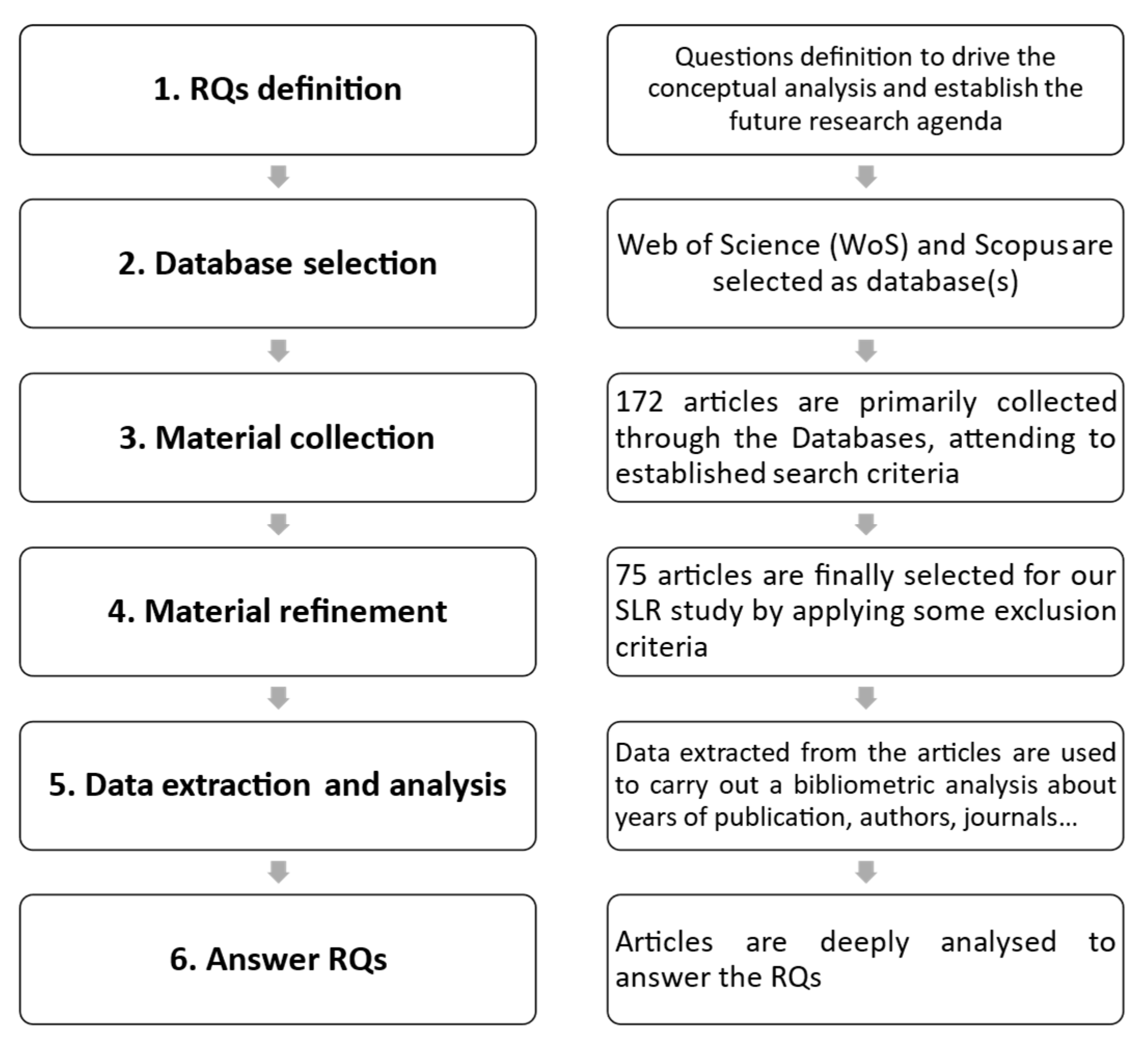
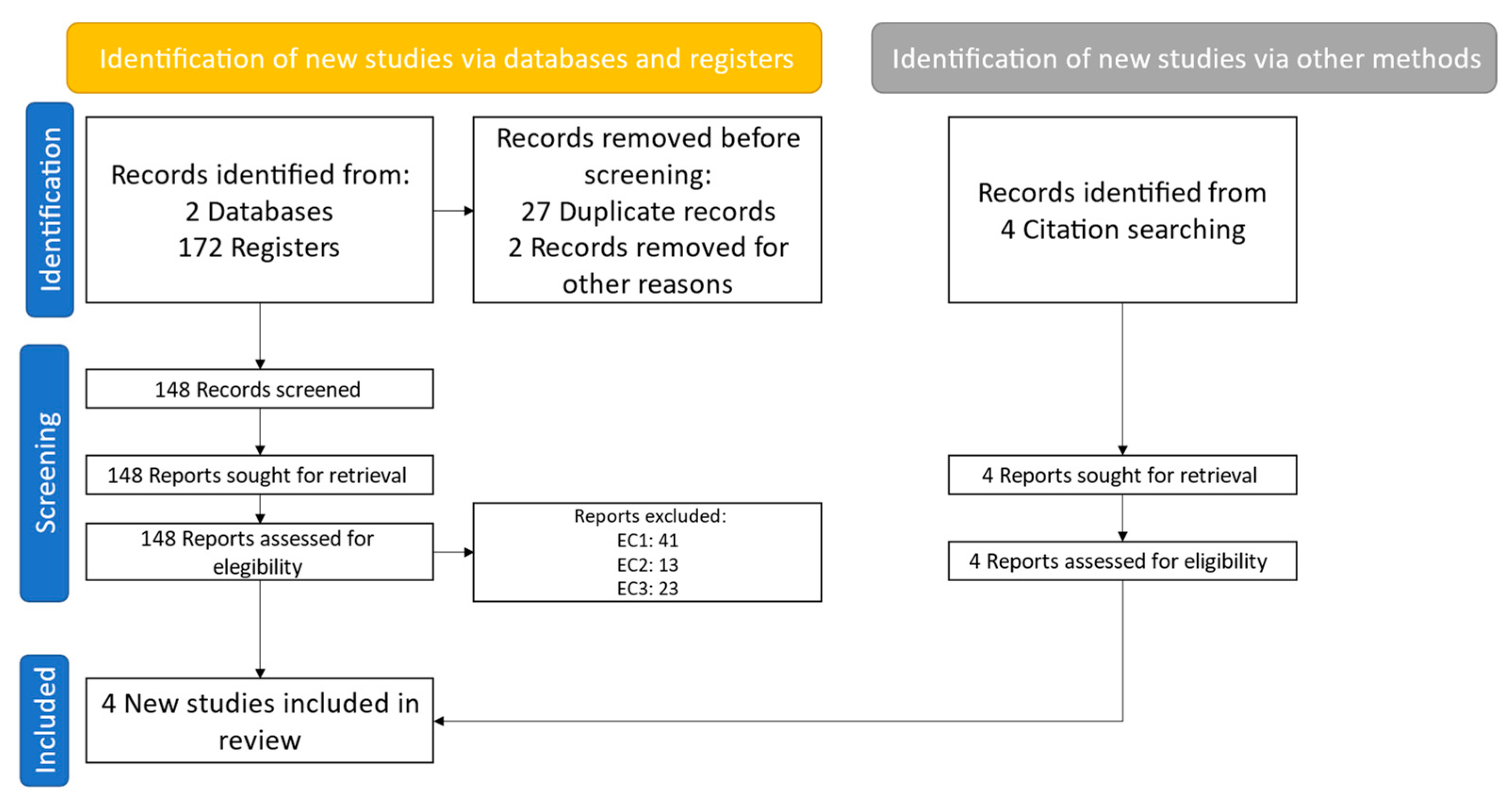
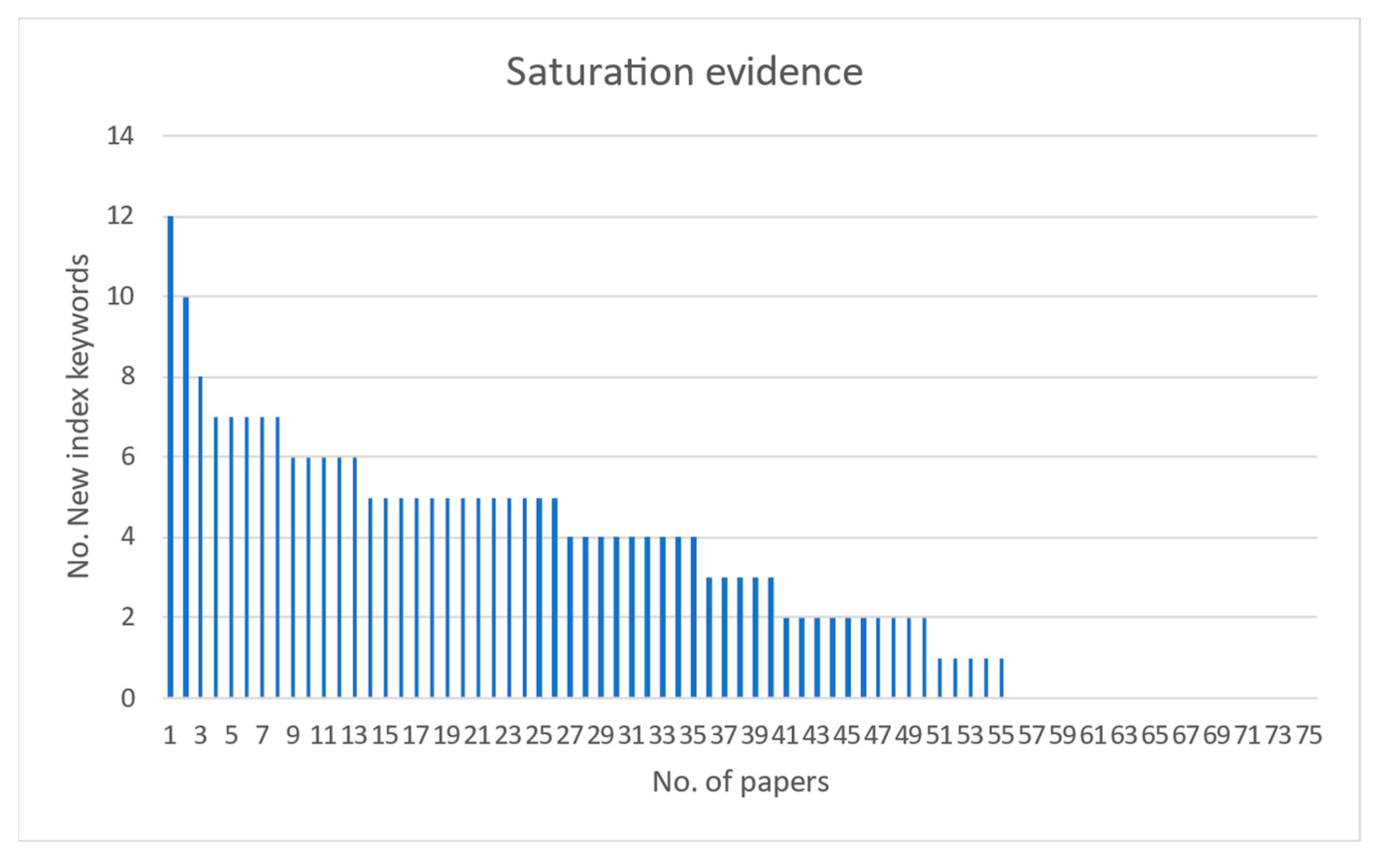
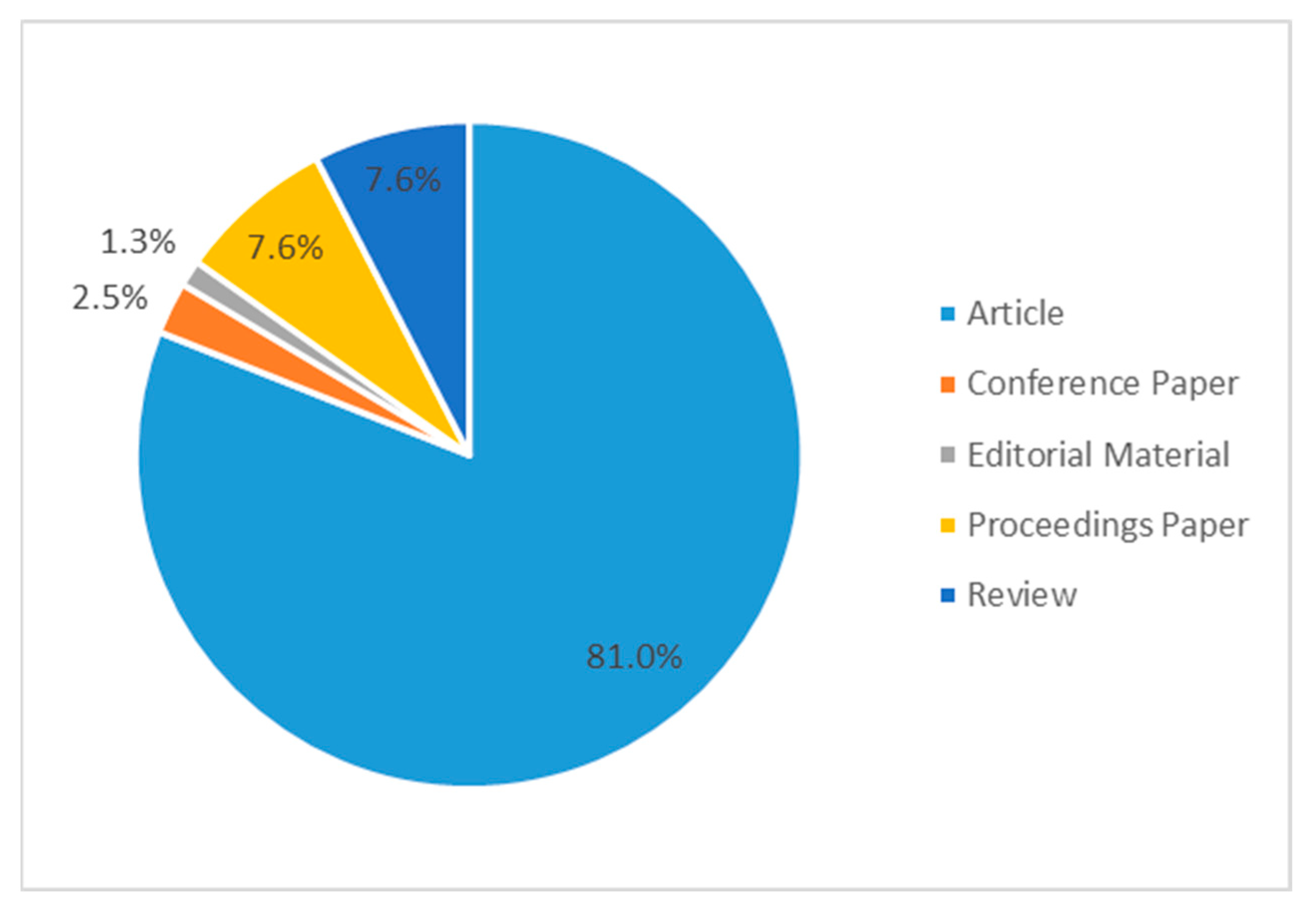
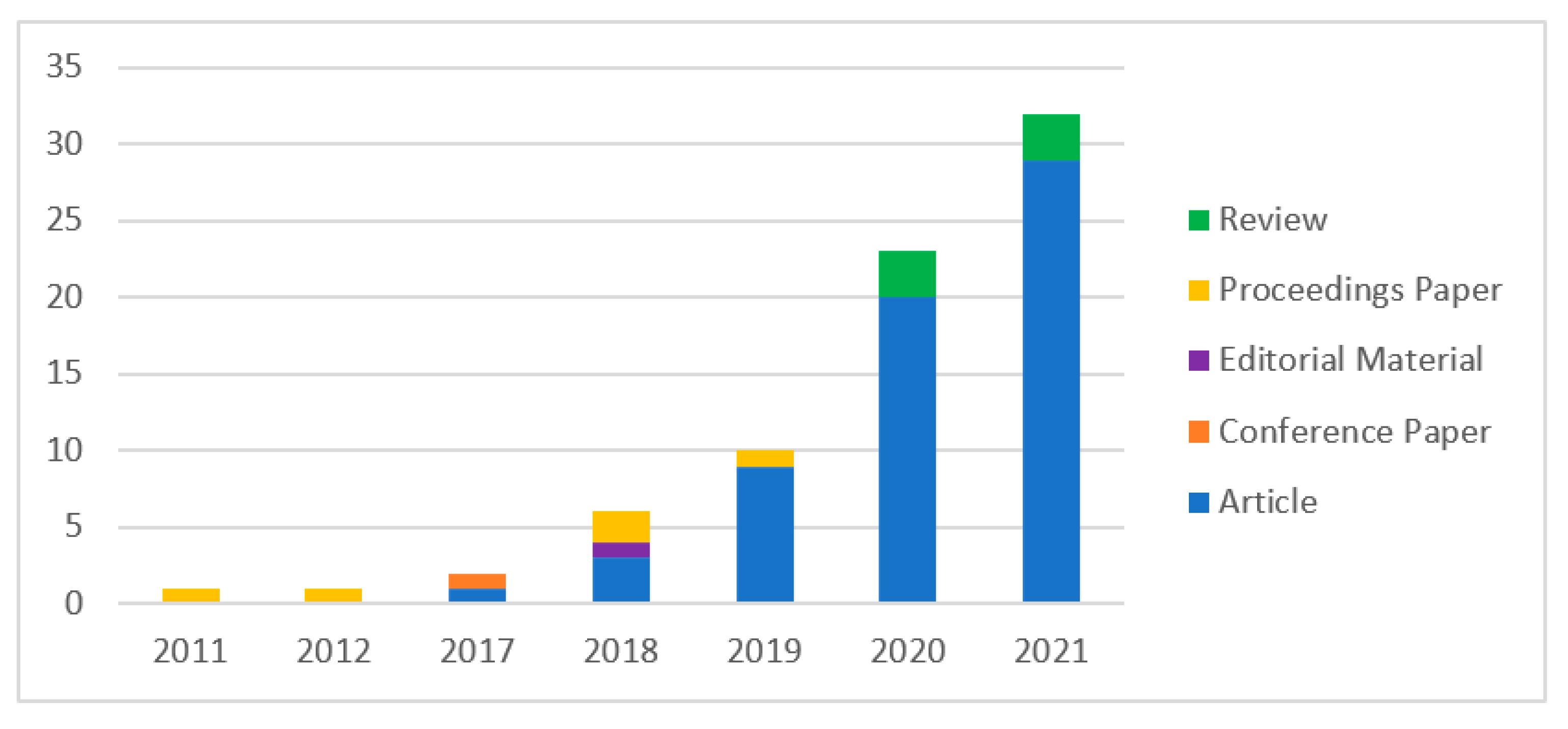

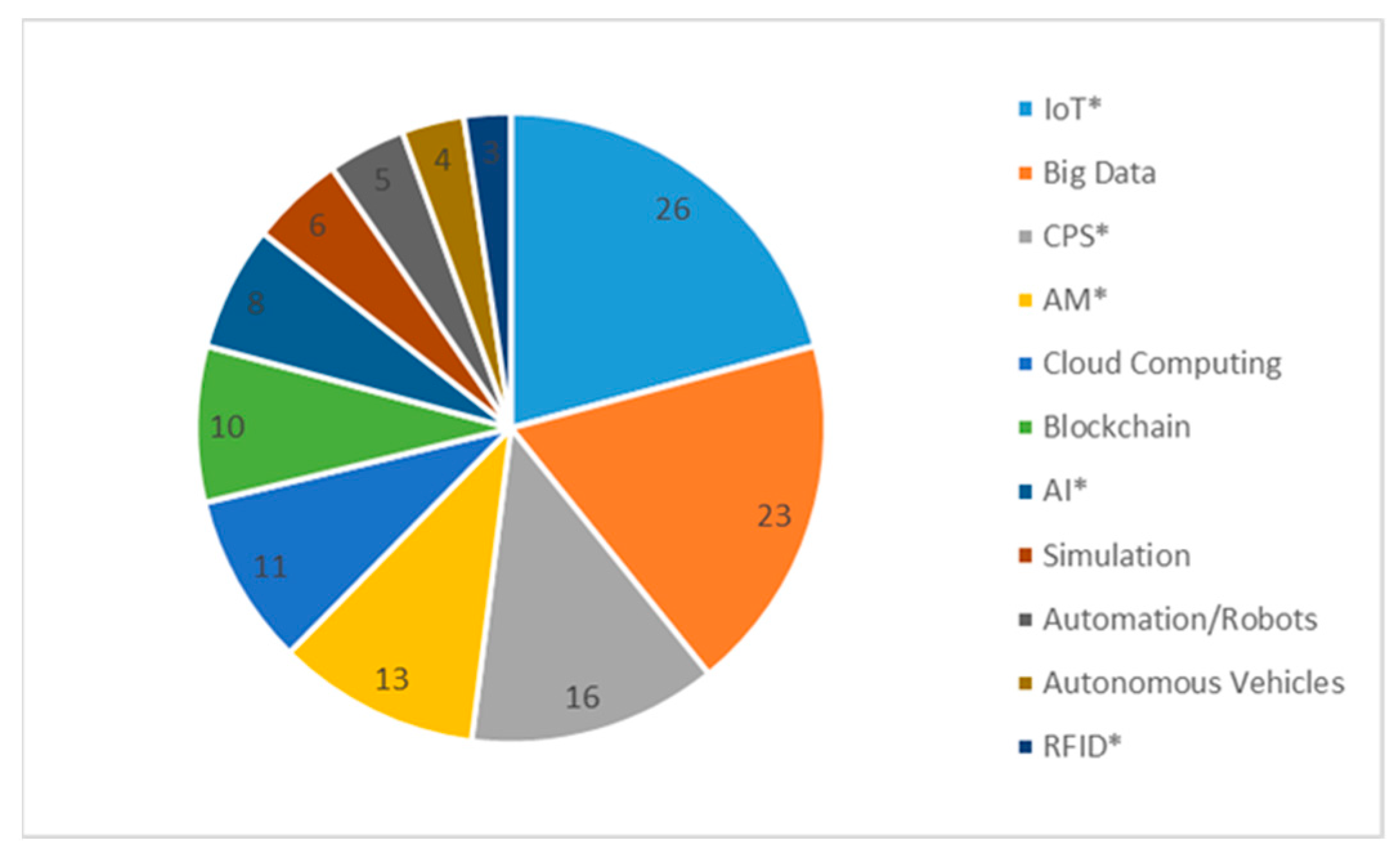

| Review Question | Motivation |
|---|---|
| RQ1: how do individual or combined Industry 4.0-related technologies contribute to the implementation of a GSC in the literature? | There is not a specific literature review study about the use of technologies 4.0; therefore, our RQ1 intends to fill this gap. Furthermore, managers and scholars could easily identify how to obtain a green benefit from technologies associated with Industry 4.0. |
| RQ2: In which aspects of the GSC is the implementation of Industry 4.0-associated technologies being studied? What are the benefits of this implementation? | There is a wide range of aspects and practices involved in GSCs [28]. Therefore, it is interesting to know which of these aspects can be improved with the use of technologies related to 4.0. |
| RQ3: what challenges of implementing technologies related to Industry 4.0 in a GSC have been identified from the literature? | Challenge identification is crucial to succeed in implementation. |
| Individual Technologies | |
|---|---|
| AI | [81,88,89,90,91,92] |
| AM | [1,11,12,92,93,94,95,96,97,98,99,100] |
| Autonomous vehicles | [92,93,94,98] |
| Automation/robotics | [92,93,94,97,98] |
| Big data | [11,92,96,101,102,103,104] |
| Blockchain | [57,92,96,105,106,107,108] |
| Cloud computing | [11,92] |
| IoT | [79,92,96,98,109] |
| Simulation | [12,92,94,110] |
| Combined technologies | |
| IoT and big data | [111,112] |
| IoT and CPS | [78,113] |
| IoT and RFID | [114,115] |
| IoT, big data, and CPS | [16] |
| IoT, big data, and cloud computing | [80] |
| IoT, big data, CPS, and cloud computing | [116,117,118,119] |
| IoT, big data, CPS, cloud computing, and AI | [106] |
| IoT, big data, CPS, cloud computing, and simulation | [120] |
| IoT, CPS, big data, cloud computing, simulations, AI, AM, and autonomous vehicles | [97] |
| Reverse Logistic | Green Design | Green Manufacturing | Carbon Emissions Management | Green Warehousing | ||||||
|---|---|---|---|---|---|---|---|---|---|---|
| Industry 4.0 technology | Recovery of the company’s end-of-life items | Design of products for reduced consumption of materials/energy | Intend to reduce products’ negative effects on the environment during their entire life cycle | Design of products for reuse, recycling, and recovery of materials and component parts | Generate minimum waste and reduce environmental pollution | Lean production | Lower raw material costs, gain production efficiency, and improve their corporate image | Carbon reduction targets | Material flow optimization | Decrease inventory levels |
| AI | [91] | [90,117] | [81,89,106] | [92] | [98] | |||||
| AM | [9] | [11,94,100] | [1,12,93,97,99] | [95] | [96] | [92] | [98] | |||
| Automation/robots | [93] | [92] | [98] | |||||||
| Autonomous vehicles | [93,97] | [92] | [98] | |||||||
| Big data | [12,97] | [88,90,116,117,118] | [11,80,96,101,103,106,111,112] | [119,120] | ||||||
| Blockchain | [105] | [90] | [57,106,121] | [92,108] | [98] | |||||
| Cloud computing | [9] | [97] | [116,117,118] | [11,80] | [119,120] | [92] | [98] | |||
| CPS | [9] | [12,94,97] | [116,117,118] | [11,78,106,113] | [119,120,135] | [98] | ||||
| IoT | [9,11,114] | [12,94,97,99] | [88,116,117,118] | [11,78,96,106,111,112,113] | [119,120,135] | [92] | [98] | |||
| RFID | [9,114,115] | |||||||||
| Simulation | [94] | [12,97] | [120] | [92] | ||||||
| Unspecified | [136] | [134] | [93,123,125,137] | [83,122,126,127,128,129,130,131,138] | [77,132,133,139,140] | [10] | [125] | |||
| Total | 13 | 2 | 1 | 3 | 25 | 29 | 35 | 12 | 10 | 8 |
Disclaimer/Publisher’s Note: The statements, opinions and data contained in all publications are solely those of the individual author(s) and contributor(s) and not of MDPI and/or the editor(s). MDPI and/or the editor(s) disclaim responsibility for any injury to people or property resulting from any ideas, methods, instructions or products referred to in the content. |
© 2023 by the authors. Licensee MDPI, Basel, Switzerland. This article is an open access article distributed under the terms and conditions of the Creative Commons Attribution (CC BY) license (https://creativecommons.org/licenses/by/4.0/).
Share and Cite
Morella, P.; Lambán, M.P.; Royo, J.; Sánchez, J.C.; Latapia, J. Technologies Associated with Industry 4.0 in Green Supply Chains: A Systematic Literature Review. Sustainability 2023, 15, 9784. https://doi.org/10.3390/su15129784
Morella P, Lambán MP, Royo J, Sánchez JC, Latapia J. Technologies Associated with Industry 4.0 in Green Supply Chains: A Systematic Literature Review. Sustainability. 2023; 15(12):9784. https://doi.org/10.3390/su15129784
Chicago/Turabian StyleMorella, Paula, María Pilar Lambán, Jesús Royo, Juan Carlos Sánchez, and Jaime Latapia. 2023. "Technologies Associated with Industry 4.0 in Green Supply Chains: A Systematic Literature Review" Sustainability 15, no. 12: 9784. https://doi.org/10.3390/su15129784
APA StyleMorella, P., Lambán, M. P., Royo, J., Sánchez, J. C., & Latapia, J. (2023). Technologies Associated with Industry 4.0 in Green Supply Chains: A Systematic Literature Review. Sustainability, 15(12), 9784. https://doi.org/10.3390/su15129784







